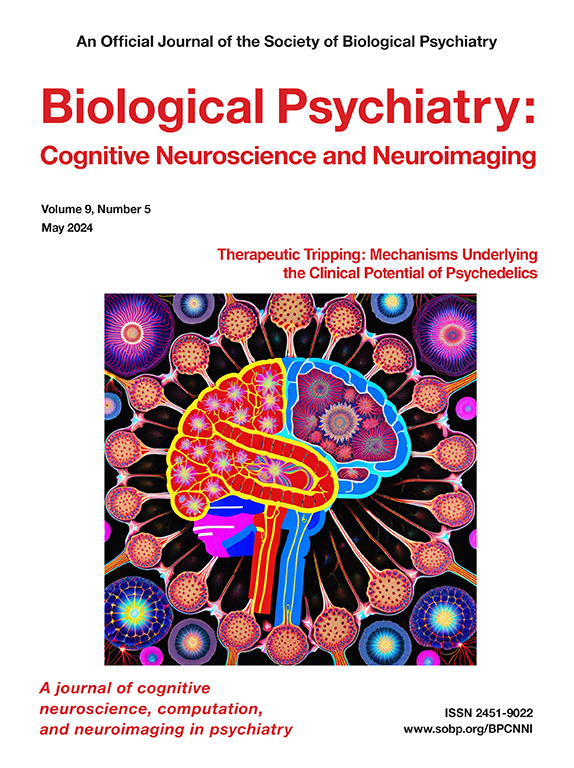Difficult-to-Treat Anxiety: A Neurocomputational Framework
IF 4.8
2区 医学
Q1 NEUROSCIENCES
Biological Psychiatry-Cognitive Neuroscience and Neuroimaging
Pub Date : 2025-09-01
DOI:10.1016/j.bpsc.2025.03.008
引用次数: 0
Abstract
Anxiety disorders, affecting approximately 1 in 9 individuals globally, impose significant socioeconomic and health burdens, with many individuals failing to achieve symptom remission despite standard treatments. Difficult-to-treat anxiety (DTA) encompasses a broad spectrum of persistent anxiety disorders that remain refractory to conventional interventions, necessitating a shift from rigid response-based criteria to a mechanistically driven framework that integrates computational psychiatry and systems neuroscience. Dysregulated approach-avoidance decision making, where heightened punishment sensitivity, inflexible belief updating, and uncertainty misestimation drive persistent avoidance behaviors and reinforce maladaptive anxiety cycles, is central to DTA. Computational modeling of reinforcement learning tasks reveals exaggerated Pavlovian biases and impaired exploratory learning, while predictive processing models highlight overestimation of threat and rigidity in safety learning, perpetuating chronic anxiety. Neural dysfunction in default mode and negative affective networks, characterized by hyperstable attractor states in the amygdala and impaired top-down regulation by the prefrontal cortex, further sustains maladaptive anxiety states. Novel interventions that target these dysfunctions—such as neuromodulation, precision pharmacotherapy, and personalized digital therapeutics—offer potential breakthroughs in managing DTA. In this review, we synthesize current evidence on computational, neural, and behavioral mechanisms that underlie DTA and propose an integrative, process-targeted approach to assessment and treatment. Future research must refine biomarker-driven subtyping and individualized interventions, moving beyond trial-and-error approaches toward mechanistically informed precision psychiatry for persistent anxiety disorders.
难以治疗的焦虑:一个神经计算框架。
焦虑症影响着全球大约九分之一的人,给社会经济和健康带来了沉重的负担,许多人尽管接受了标准治疗,但仍未能实现症状缓解。难治性焦虑(DTA)涵盖了广泛的持续性焦虑障碍,这些障碍对传统干预措施仍然是难治性的,因此需要从僵化的基于反应的标准转变为结合计算精神病学和系统神经科学的机械驱动框架。DTA的核心是方法回避决策的失调,其中惩罚敏感性升高,信念更新不灵活,不确定性错误估计驱动了持续的回避行为,并强化了适应不良的焦虑循环。强化学习任务的计算模型揭示了夸大的巴甫洛夫偏见和受损的探索性学习,而预测处理模型强调了对安全学习的威胁和僵化的高估,使慢性焦虑长期存在。默认模式和消极情感网络的神经功能障碍,以杏仁核的超稳定吸引状态和前额叶皮层自上而下的调节受损为特征,进一步维持了适应不良的焦虑状态。针对这些功能障碍的新干预措施,如神经调节、精确药物治疗和个性化数字治疗,为管理DTA提供了潜在的突破。这篇综述综合了目前关于DTA的计算、神经和行为机制的证据,提出了一种综合的、以过程为目标的评估和治疗方法。未来的研究必须完善生物标志物驱动的亚型和个性化的干预措施,从试错法转向针对持续性焦虑症的机械信息、精确精神病学。
本文章由计算机程序翻译,如有差异,请以英文原文为准。
求助全文
约1分钟内获得全文
求助全文
来源期刊

Biological Psychiatry-Cognitive Neuroscience and Neuroimaging
Neuroscience-Biological Psychiatry
CiteScore
10.40
自引率
1.70%
发文量
247
审稿时长
30 days
期刊介绍:
Biological Psychiatry: Cognitive Neuroscience and Neuroimaging is an official journal of the Society for Biological Psychiatry, whose purpose is to promote excellence in scientific research and education in fields that investigate the nature, causes, mechanisms, and treatments of disorders of thought, emotion, or behavior. In accord with this mission, this peer-reviewed, rapid-publication, international journal focuses on studies using the tools and constructs of cognitive neuroscience, including the full range of non-invasive neuroimaging and human extra- and intracranial physiological recording methodologies. It publishes both basic and clinical studies, including those that incorporate genetic data, pharmacological challenges, and computational modeling approaches. The journal publishes novel results of original research which represent an important new lead or significant impact on the field. Reviews and commentaries that focus on topics of current research and interest are also encouraged.
 求助内容:
求助内容: 应助结果提醒方式:
应助结果提醒方式:


